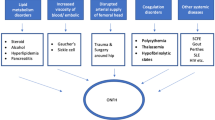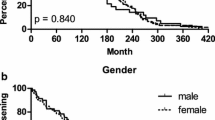Abstract
The OPG/RANK/RANKL system has been implicated in the biological cascade of events initiated by particulate wear debris and bacterial infection resulting in periprosthetic bone loss around total hip arthroplasties (THA). Individual responses to such stimuli may be dictated by genetic variation caused by single nucleotide polymorphisms (SNPs). Case control study of the osteoprotegerin and RANK genes for possible association with deep sepsis or aseptic loosening. All patients were Caucasian and had had a cemented Charnley THA and polyethylene acetabular cup. Cases consisted of 91 patients with early aseptic loosening and 71 patients with deep infection. Controls were 150 clinically and radiologically well-fixed THAs. DNA samples were genotyped using Taqman allelic discrimination. The A allele (p<0.001) and genotype A/A (p<0.001) for the OPG-163 SNP were associated with aseptic failure. Additionally, the RANK +575 (C/T SNP) T allele (p=0.004) and T/T genotype (p=0.008) frequencies were associated with aseptic failure. Comparing the septic group with the controls, the frequency of the A allele (p<0.001) and the genotype A/A (p<0.001) for the OPG-163 SNP were statistically significant. Aseptic loosening and deep infection of THA may be under the influence of susceptibility genes. SNP markers may serve as predictors of implant survival.
Résumé
Le système OPG/RANK/RANKL est impliqué dans la cascade des événements initiés par les débris d’usure et l’infection, conduisant à l’ostéolyse périprothètique de la hanche. La réponse individuelle est peut-être génétique, à cause du polymorphisme des nucléotides (SNPs). étude, avec groupe contrôle, des gènes RANK et ostéoprotégérine, et de l’association possible avec l’infection ou le descellement aseptique. Tous les patients étaient caucasiens et avaient eu une prothèse totale de hanche type Charnley avec cupule en polyéthylène. Il y avaient 91 patients avec un descellement aseptique précoce et 71 avec une infection profonde. Le groupe contrôle était constitué de 150 arthroplasties bien fixées cliniquement et radiologiquement. Les échantillons d’ADN étaient génotypés en utilisant la discrimination allèlique Taqman. L’allèle A (p<0,001) et le génotype A/A (p<0,001) pour l’OPG-163SNP était associé avec un échec aseptique. De plus, l’allèle RANK+575 (C/T SNP) T (p=0,004) et le génotype T/T étaient associés a l’échec aseptique. Entre le groupe septique et le groupe contrôle , la fréquence de l’allèle A (p<0,001) et du génotype A/A (p<0,001) pour l’OPG-163SNP était statistiquement différente. Le descellement aseptique et l’infection profonde d’une arthroplastie totale de la hanche peuvent être sous l’influence d’une susceptibilité génétique et les marqueurs spécifiques peuvent servir d’éléments prédictifs de la survie de l’implant.
Similar content being viewed by others
References
Archibeck MJ, Jacobs JJ, Roebuck KA, Glant TT (2001) The basic science of periprosthetic osteolysis. Instr Course Lect 50:185–195
Arko B, Prezelj R, Komel A, Kocijancic A, Hulder P, Marc J (2002) Sequence variations in the osteoprotegerin gene promoter in patients with postmenopausal osteoporosis. J Clin Endocrinol Metab 87(9):4080–4084
Childs LM, Paschalis EP, Xing L et al (2002) In vivo RANK signalling blockade using the receptor activator of NK-kappaB: Fc effectively prevents and ameliorates wear debris-induced osteolysis via osteoclast depletion without inhibiting osteogenesis. J Bone Miner Res 17:192–199
Clohisy D (2003) Cellular mechanisms of osteolysis. J Bone Joint Surg [A] 85(Suppl 1):4–6
DeLee JG, Charnley J (1976) Radiological demarcation of cemented sockets in total hip replacement. Clin Orthop 121:20–32
Gehrke T, Sers C, Moraweitz L et al (2003) Receptor activator of nuclear factor kappaB ligand expressed in resident and inflammatory cells in aseptic and septic prosthetic loosening. Scand J Rheumatol 32(5):287–294
Gruen TA, McNeice GM, Amstutz HC (1979) “Modes of failure” of cemented stem-type femoral components: a radiographic analysis of loosening. Clin Orthop 141:17–27
Harris WH, McCarthy JC, O’Neill DA (1982) Femoral component loosening using contemporary techniques of femoral cement fixation. J Bone Joint Surg [A] 7:1063–1067
Haynes DR, Crotti TN, Potter AE et al (2001) The osteoclastogenic molecules RANKL and RANK are associated with periprosthetic osteolysis. J Bone Joint Surg [B] 83:902–911
Hodgkinson JP, Shelley P, Wroblewski BM (1988) The correlation between the roentographic appearance and the operative findings at the bone-cement junction of the socket in Charnley low-friction arthroplasties. Clin Orthop 228:105–109
Hofbauer LC, Kholsa S, Dunstan CR, Lacey DL, Boyle WJ, Riggs BL (2000) The roles of osteoprotegerin and osteoprotegerin ligand in the paracrine regulation of bone resorption. J Bone Miner Res 15:2–12
Holstead Jones D, Kong Y-Y, Penninger JM (2002) Role of RANKL and RANK in bone loss and arthritis. Ann Rheum Dis 61(Suppl 2):32–39
Honore P, Luger NM, Sabino MA et al (2000) OPG blocks bone cancer-induced skeletal destruction, skeletal pain and pain-related neurochemical reorganization of the spinal cord. Nat Med 6:521–528
Konttinen YT, Xu J-W, Patiala H et al (1997) Cytokines in aseptic loosening of total hip replacement. Curr Orthop 11:40–47
Langdahl BL, Carstens M, Stenkjaer L, Eriksen EF (2002) Polymorphisms in the osteoprotegerin gene are associated with osteoporotic fractures. J Bone Mineral Res 17(7):1245–1255
Mandelin J, Li T-F, Liljestrom M et al (2003) Imbalance of RANK/RANKL/OPG system in interface tissue in loosening of total hip replacement. J Bone Joint Surg [B] 85:1196–1201
Ohmori H, Makita Y, Funamizu M et al (2002) Linkage and association analyses of the osteoprotegerin gene locus with human osteoporosis. J Hum Genet 47:400–406
Pacheco V, Shelley P, Wroblewski BM (1988) Mechanical loosening of the stem in Charnley arthroplasties. J Bone Joint Surg [B] 70:596–599
Ross FP (2000) RANKing the importance of measles virus in Paget’s disease. J Clin Invest 105:555–558
Simonet WS, Lacey DL, Dunstan CR et al (1997) Osteoprotegerin: a novel secreted protein involved in the regulation of bone density. Cell 89:309–319
Suda T, Takahashi N, Martin TJ (1992) Modulation of osteoclast differentiation. Endocr Rev 13:66–80
Wuyts W, Van Wesenbeck L, Morales-Piga A et al (2001) Evaluation of the role of RANK and OPG genes in Paget’s disease of bone. Bone 28(1):104–107
Author information
Authors and Affiliations
Corresponding author
Additional information
An erratum to this article can be found at http://dx.doi.org/10.1007/s00264-007-0473-z
Rights and permissions
About this article
Cite this article
Malik, M.H.A., Bayat, A., Jury, F. et al. Genetic susceptibility to hip arthroplasty failure—association with the RANK/OPG pathway. International Orthopaedics (SICO 30, 177–181 (2006). https://doi.org/10.1007/s00264-006-0074-2
Received:
Revised:
Accepted:
Published:
Issue Date:
DOI: https://doi.org/10.1007/s00264-006-0074-2




